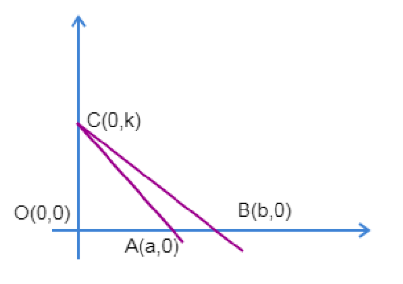Question
Question: Let A(a,0) and B(b,0) be fixed distance points on the x-axis, none of which coincides with the origi...
Let A(a,0) and B(b,0) be fixed distance points on the x-axis, none of which coincides with the origin O(0,0), and let C be a point on the y-axis. Let L be a line through the O(0,0) and perpendicular to the line AC. The locus of the point of intersection of the lines L and BC if C varies along the y-axis, is (provided c2+ab=0).
(a) ax2+by2=x
(b) ax2+by2=y
(c) bx2+ay2=x
(d) bx2+ay2=y
Solution
Hint: Assume a variable point C on y axis as (0,k) and find the slope of the line AC. Using the perpendicularity condition of lines, find the slope of the line C and thus the equation of line L. Finally, substitute the expression of k that you have obtained from L on the line BC for the required locus.
Given A(a,0)and B(b,0) are two fixed points on x axis, let us assume the variable point C on y axis as (0,k).
Plotting the diagram with the above data, we will have it as:

Then the slope of the line AC is given as:
m=x2−x1y2−y1
m=0−ak−0
m=a−k
Now the slope of the line perpendicular to line AC is m−1, since the product of slopes of perpendicular lines is -1.
Therefore, the equation of line L passing through origin and perpendicular to AC is given as:
y=(m−1)x
y=(ka)x
k=yax
Now the equation of line BC can be found out using ax+by=1(intercept form) where a and b are x-intercepts and y-intercept respectively.
Therefore, the equation of line BC is:
ax+ky=1
Substituting k=yax in the above equation we will have:
bx+(yax)y=1
bx+axy2=1
